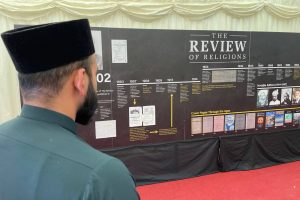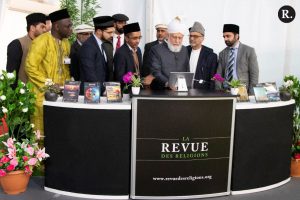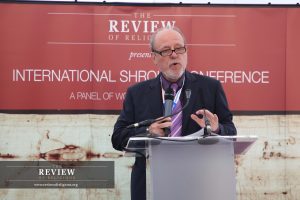In August 2016, The Review of Religions held a unique exhibit at the 50th annual Jalsa Salana—or Annual Convention—of the Ahmadiyya Muslim Community in the U.K., which had over 35,000 attendees.
Unless otherwise stated, photos taken in this article by Zubair Hayat of The Review of Religions team
With three different components, the exhibition provided a unique interfaith perspective and interactive experience for guests.
The first component was an exquisite collection of early copies of the Holy Qur’an and other relics, organized by The Review of Religion’s head of special collections, Razwan Baig. Here, too, the special collection was illuminated from a talk given by Razwan Baig himself, covering the changes in Islamic calligraphy and the diverse materials used to pen these works of art.
The second component was an extensive exhibit of the Turin Shroud, including a rare life-size replica of the Shroud brought by Pam Moon and her team, Brenda Benton, Stuart Benton, and Luigi Antoniaz. Hugh Farey, editor of the British Society for the Turin Shroud newsletter, was also in attendance to speak about his unique view of the Shroud, while world-renowned Shroud expert Barrie Schwortz returned to give several well-attended talks on the Shroud.
Finally, guests were able to participate in a unique interactive experience: the Al-Qalam project. Originated by Razwan Baig and sponsored by The Review of Religions, this ambitious project asks each guest to pen one verse of the Holy Qur’an in Arabic. This will lead to a unique document highlighting the diversity of Muslims—men and women, young and old, black and white and brown—while also highlighting their unity: belief in one book for guidance and for comfort.
Join us on the following pages and enjoy.
A Unique Collection

The first highlight of the exhibition was an exquisite collection of old and ancient copies of the Holy Qur’an, highlighting the many beautiful ways that this text has been preserved, illuminated and illustrated over the centuries.
Over time, different calligraphers from different parts of the globe developed a variety of scripts in which to write the Qur’an, honing their craft in an attempt to make the appearance of the words on the page as beautiful as the words themselves.
In addition, many copies of the Qur’an were distinctive in their use of gold leaf, illustration, and use of rare materials for the ink. These copies of the holy text were truly works of art and took many months to complete.
Amassing such a collection takes time, patience, and perseverance. Razwan Baig slowly developed this collection of copies of the Holy Qur’an and other artifacts over several decades, and he graciously brought back these treasures for attendees to see and admire.
While this is a relatively newer copy of the Qur’an, it has a very distinctive feature in that it is made of Indonesian daluang paper, which was made from the bark of the saeh, or mulberry, tree.

This manuscript showcases the care and precious materials that were used in embellishing copies of the Holy Qur’an. This particular manuscript uses gold and rubies to embellish and decorate the pages.

Although copies of the Holy Qur’an were indeed the highlight of the collection, other artifacts included ceramics with calligraphy on them. In this instance, these bowls display the rare Kufic script. These particular examples are said to be from the 12th century.

Thought to be from the state of Bihar, in India, from around the early 15th century, this Qur’an would have been produced for a prince or other important person, as the word “Allah” has been written throughout in gold.

The exhibit naturally stirred media interest. Here, Razwan Baig speaks with reporters from the BBC about his collection.


The Al-Qalam Project

This year also inaugurated the Al-Qalam Project. Founded by Razwan Baig, this project brought an interactive aspect to the exhibit and drew crowds of its own. Put simply, the Al-Qalam Project aims to produce a unique copy of the Holy Qur’an: one in which each verse has been penned by a different writer, thereby celebrating the fact that many diverse people can unify behind the teachings of this one book.
Six separate stations were set up for people to sit down and write a verse each. Each station was manned by graduates of Jamia Ahmadiyya—the missionary training school—who are well-versed in Arabic, in order to ensure accuracy.
Hundreds of people lined up patiently to wait their turn to write a verse. Young and old, men and women, from countries around the world, participated in this unique opportunity. Indeed, the Al-Qalam Project brought people together in showing their love for the Holy Qur’an.
Young children were encouraged to participate and write their own verse.

Volunteers helped writers make sure they were writing down the correct verse and that there were no mistakes in the Arabic.

An attendee pens the verse assigned to him.

While some people pen their verses, others sign the guestbook. Each writer was asked to contribute information on themselves and where they were from. Once the Qur’an is completed, this will provide another unique layer—a comprehensive and fascinating profile of the participants in this project.

What is the Shroud of Turin?

The Shroud of Turin is believed by many to be the original burial cloth used to wrap the body of Jesusas after he was taken down from the cross after the Crucifixion. The cloth bears a remarkable and unexplained image, as well as blood markings consistent with what would be expected from someone who had been crucified.
The Shroud of Turin is perhaps the most famous religious relic in the modern world. The public viewings of the Shroud are limited and heavily attended. The last public exhibition of the Shroud was in 2015 where an estimated two million visitors from around the world came to Turin to view the Shroud.
A faint image is visible upon the Shroud, and it is the formation of this image that has puzzled scientific experts for decades, leading to the Shroud becoming well-known outside of religious circles. In 1978 the first, and to date only, detailed scientific examination of the Shroud of Turin was carried out by a group of 24 scientists. The group, known as Shroud of Turin Research Project, Inc. (STURP), spent two years planning the examination. They conducted their analysis over five days and nights. Their primary goal was to determine the scientific properties of the image on the Shroud and what might have caused it.
To date, the exact image formation mechanism remains unknown. No one has been able to reproduce any sort of shroud or cloth that is like the Shroud of Turin, with the same physical and chemical properties. To add further to the debate and mystery of the cloth, a carbon-dating test of one corner of the cloth, suggested the cloth was not the original that wrapped Jesus, but a 14th century creation.
The visual nature of the Shroud, the detailed depiction of the Crucifixion, the unexplained image on the cloth, and it’s supposed exposure as a 14th century fake through carbon dating all combine to make the Shroud a fascinating cloth that attracts huge attention.
Pam Moon’s Shroud Exhibition with Life-Size Replica
The Shroud exhibition, brought to the convention for the past two years by Pam Moon, details how the marks on the Shroud of Turin align with the accounts of the Crucifixion found in the New Testament.
The replica was produced using original photographs taken by Barrie Schwortz, the official documenting photographer of the STURP team which studied the Shroud in 1978. The replica has been produced to match the original Shroud’s dimensions. The replica contains the same visible details seen on the Shroud; the marks from the ‘Crown of Thorns’, evidence of whipping, a pool of blood from a wound in the side, and blood flows from the wrists down the arms.
Over the past two years the exhibition has allowed visitors to the convention to get up close to this replica and see for themselves these details. Pam’s exhibition brings the story of the Crucifixion to life, showing what a 1st Century Roman nail looked like, as well as a replica Roman flagram which would have been used to whip victims prior to crucifying them. The flagram was a whip-style weapon with dumbbell shaped pieces of metal at the end, and there is evidence on the Shroud of this weapon being used across the whole of the back of the body. Visitors to the exhibition were able to feel for themselves the weight of the metal pieces of the flagram and get some idea of the brutal punishment inflicted on Crucifixion victims.
A New Addition: The Burial Tomb
A new addition in the 2016 Shroud Exhibition at Jalsa Salana was the inclusion of a life-size image of a 1st century burial tomb. This photograph enabled visitors to appreciate the burial tomb was a large area carved in stone, in to which people could walk around, rather than a grave, giving visitors a better understanding of the circumstances at the time.

Developing New Relationships
This year Pam was able to bring three team members with her: Luigi Antoniaz, Brenda Benton and Stuart Benton. All of Pam’s team spent countless hours on their feet talking to visitors about the Shroud. During the quieter times several conversations took place between members of the Review team and Pam’s team. In particular, we had several interesting conversations with Brenda & Stuart, where they shared the story of how they got involved with the Shroud as well as contact details of other Shroud experts whom I can follow up with.

Shroud Expert Barrie Schwortz Returns to Jalsa
Barrie Schwortz is known as the leading world expert on the Shroud of Turin. He was the documenting photographer for STURP in 1978 and in 1997 built Shroud.com, the largest online website dedicated to the Shroud of Turin. Barrie’s boundless energy and unique expertise and insight into the Shroud of Turin has added a special shine to the Shroud of Turin exhibition at Jalsa Salana. Both this year, and in 2015, Barrie has delivered presentations to packed audiences detailing his first-hand experiences from examining the Shroud and explaining what we know about the Shroud from the scientific evidence.

Indeed, Barrie’s knowledge was invaluable to the exhibition, as it was Barrie who connected The Review of Religions team with Pam Moon and her exhibition. It did not take long at all for the relationship of the team with Barrie to become a highly collaborative one. We viewed him as an expert and mentor, yet he emphasised to us that he was just one of the team.
Hugh Farey, Editor of British Society for the Turin Shroud Newsletter, Adds a Different Perspective
Another Shroud researcher who came to the Jalsa, via an introduction by Barrie, was Hugh Farey. Hugh is the editor of the BSTS Newsletter. One key aspect about Hugh is that he, on balance, believes that the Shroud of Turin is not the authentic burial Shroud of Jesusas, but a medieval forgery. Having Hugh present at the exhibition gave an added dimension, as he was able to discuss the problems with certain aspects of the Shroud and the evidence for it being a forgery. Having this range of views within the group, and also some healthy debate and difference of opinion, meant we had more accurately recreated the reality of the Shroud research world; a world where varying opinions all hotly contested.

One incident in particular helped show Hugh’s passion for helping to explain the Shroud of Turin to others. To allow him to help demonstrate, especially to the young, how a Shroud wrapped around a body would lead to both the frontal and dorsal sections he decided to employ a prop. On the second day of the Jalsa he went out early before the day began to a local toy shop and purchased a small child’s doll. With the doll, and a roll of paper, he was then able to show all visitors how the Shroud was said to have wrapped the body.

© The Review of Religions
“[The Ahmadiyya Community] would invite a Jewish man, to discuss a Christian relic, at a Muslim Organisation!’ – Barrie Schwortz – Jalsa Salana 2015

The coming together of members of Judaism, Islam and Christianity in the organisation and running of the Shroud Exhibition was another key aspect of its importance and significance to those involved in planning the event. Barrie Schwortz, the leading world expert on the Shroud of Turin, highlighted this coming together of members of different faiths as one key reason he was so fully supportive of the being part of the Shroud exhibition at Jalsa Salana.

© Makhzan-e-Tasaweer
In a time when there is widespread conflict and turmoil in the world, often linked to religious differences and intolerance, those involved in this exhibition felt it signified an important unity between those of different faiths.




Add Comment